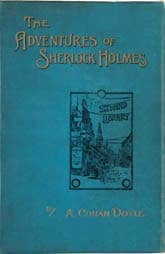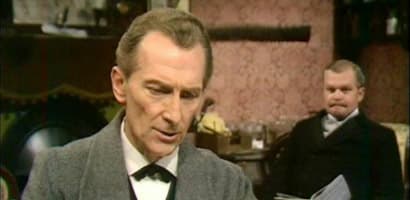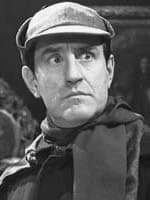The Adventures of Sherlock Holmes
Critique Quotes Text Sherlock Holmes at the movies
 First edition
First editionFirst publication
1892
Literature form
Story collection
Genres
Crime, mystery
Writing language
English
Author's country
England
Length
Twelve stories, approx. 94,000 words

Peter Cushing is a flinty Holmes in several incarnations, backed here by Nigel Stock as Watson.
Cushing and the professional Sherlocks
The Hound of the Baskervilles (1959): Film, 87 minutes; director Terence Fisher; writer Peter Bryan; featuring Peter Cushing, Andrι Morell, Christopher Lee
Sherlock Holmes (19641968): Television series, 29 episodes; featuring Douglas Wilmer (19641965), Peter Cushing (1968), Nigel Stock
The Masks of Death (1984): Television film, 78 minutes; director Roy Ward Baker; writer Anthony Hinds, N.J. Crisp; featuring Peter Cushing, John Mills, Anne Baxter, Ray Milland
During the period of cultural upheaval in the late 1950s and 1960s you might expect Sherlock Holmes to be perceived as a relic of a stodgy earlier age. Filmed and televised crime stories then were all about gunfights and car chases, nothing like the refined intellectual labour of Sherlock Homes and his imitators.
Yet right there remained a fascination with, or at least a curiosity about, Doyle's creation. Appropriately, the most prominent Holmeses of the time were portrayed by classically trained British stage actors and veteran lights of the British horror cinema, who took Holmes seriously—and took him into his middle and later years.
In the years after Rathbone retired his magnifying glass, the most celebrated Holmes may have been Peter Cushing (best known to a younger audience as the evil Grand Moff Tarkin in Star Wars), though we may have to thank the actor he replaced on a television series for giving us back the real Holmes.
Not-so-scary Hound
Cushing started playing Holmes in Hammer Studio's The Hound of the Baskervilles in 1959, which co-starred his horror-film colleague Christopher Lee as Sir Henry Baskerville. The film was helmed by their talented Hammer director Terence Fisher. Together they'd all done a ripping Curse of Frankenstein two years earlier, a great Dracula the year before, and a decent version of The Mummy the same year as Hound.
Odd then that Hound, which was known as Doyle's darkest tale, seems too light and sunny in this remake. Perhaps because this is the first version of Hound to be shot in colour. Only the dark night scenes on the moor carry the requisite mood of doom.
Cushing is not as imposing as Rathbone as the detective, being smaller and finer featured, but he possesses a flinty intelligence that works well. He seems to take very seriously his intention to portray Holmes honestly, bringing out his austere and prickly sides, the serial depressive of the novels—not so much as to put off his admirers but with a hint of the man's anti-social nature that had been missing in earlier productions.
To balance him, he has a capable and pleasantly dull Watson. Andrι Morell has to actually carry about half the movie, as Watson handles matters at the Baskerville home, meeting characters and unearthing clues, while Holmes skulks in the background, until his dramatic re-appearance in the case.
Lee has little to work with here as Holmes's client, with scenes of mainly awkward romance and dull-witted victimization. If all your relatives had met gruesome ends and your own murder has been threatened, would you continually wander onto the moors alone at night?
Maybe people weren't ready for such a faithful take on the legendary story, for the Hammer Hound was less successful than the studio's more outright horror fare. However, this version has risen in Holmes fans estimation over the years and now takes its place beside the 1940s classic.
Shrunken Sherlock
Nearly a decade later, Cushing reprised his role in the 1968 series Sherlock Holmes for British television, when he replaced classical actor Douglas Wilmer who had been been Holmes in the 1964–1965 instalment of the BBC series.
Wilmer respected Doyle's work, for which we have to thank for the relative faithfulness of the series instalments which were express adaptations of the original stories. The actor, known before this role as an interpreter of Shakespeare, ended up rewriting many of the episodes, which he considered to have been written and produced shoddily.
Wilmer too was interested in presenting the dark side of Holmes, which had been played down in most previous outings to make him more affable. Wilmer's long, somewhat lugubrious face and his often haughty manner as Holmes, looking down his substantial nose, helped to distance him from the audience, leaving it to the competent Nigel Stock to engage their sympathies as Watson, representative of everyman.
The series was launched in 1964 with "The Speckled Band" as the pilot. Today the black-and-white film appears somewhat stagy but it is a decent version of the story. The conclusion however, as with many of the succeeding episodes, is anticlimactic, failing to dramatize the story beyond the solving of the puzzle.
It was quite popular at the time though and twelve more episodes were produced the next year. Titles include some of the best Holmes mysteries they could get the rights to, including "The Red Headed League", "The Copper Beeches", "The Man with the Twisted Lip", "The Six Napoleons" and "The Beryl Coronet".
Despite Wilmer's misgivings, the hour-long episodes range from good to excellent as adaptations. They are generally true to the basics of the stories, though their presentations are often rearranged. For example, although Conan Doyle usually begins each case with clients calling on Holmes and Watson, most of these televised episodes begin with the on-site dramatics involving the victims and suspects and don't bring in the detectives until ten minutes in.
This 1965 season was also very popular with British viewers, but Wilmer, who fought with management, refused to return. Ten of his episodes survive in their entirety and are available, along with the pilot, on DVD, albeit in rather sloppy transfers.
This short television run, however, led to Wilmer being identified with Holmes in the minds of a generation of fans. He also made a series of audio recordings of the stories and briefly returned as Holmes, alongside Stock as Watson, in Gene Wilder's parody The Adventure of Sherlock Holmes' Smarter Brother in 1975.
A long search for Wilmer's successor on the TV series ended with the natural choice: Peter Cushing. As might be expected, Cushing plays Holmes in this series with an austere coldness, as if he's always mildly irritated about something. Perhaps he's annoyed with the show's producers, as he experienced the same difficulties with low production values as Wilmer had. This however also works to distinguish his Holmes as the most disdainfully rational of the lot—although he could indulge in a convivial chuckle with Watson when it is called for.
Cushing's Watson continued to be played by Nigel Stock and the two of them created another memorable duo, acting out more episodes adapted from Doyle's stories—although this time in colour and with more natural, less theatrical presentation. Television had come a long way between 1965 and 1968. Still the acting is a little overdone (though never from Cushing or Stock) and the sound is a little hollow.
First up, is "The Hound of the Baskervilles" in two parts—Cushing's second turn as Holmes in the thriller on the moors. This one doesn't have the sweep and slick production of his 1959 film, but it is not bad for television of the time. On some points it follows Arthur Conan Doyle's novel more closely and on other points it departs radically in the interests of compression; the best parts of the two adaptations together would make up one very long and faithful Hound of the Baskervilles.
The worst part of this production is the very abrupt and unsatisfying ending, a failing that strangely afflicts several of the other surviving episodes in the Cushing series.
Most of those episodes are taken from Doyle's first two novels and first collection of stories (The Adventures of Sherlock Holmes). Because "A Study in Scarlet"—taken from the novel in which Holmes and Watson first meet—is not the first episode in the series' order, it must proceed with the mystery as though the two are already old friends. But, for the most part, this and successive entries are quite faithful to the Doyle canon.
They proved even more popular than in the shows run three years earlier, but one season was enough for Cushing. He left the show, which never returned. Only five of the Cushing episodes have survived (including "The Sign of Four", "The Blue Carbuncle" and "The Boscombe Valley Mystery") and are available.
Cushing's last bow
Then in 1984 Peter Cushing played his favourite role one more time. His final Holmes in The Masks of Death was an elderly Sherlock who comes out of retirement for one more case.
Co-starring John Mills as Watson, along with Ann Baxter and Ray Milland, the British television film was a triumph, despite not being based on a Doyle story.
A sequel was planned but health issues prevented Cushing from performing as Holmes again.
— Eric
Critique Quotes Text Sherlock Holmes at the movies
1922, 19291933, 19311937, 19391946, 19541955, 19591984, 19621992, 1965, 1970, 19751988, 1976, 1979, 1982, 19841994, 20002002, 2002, 2002b, 20092011, 20102017, 20122019, 2015




